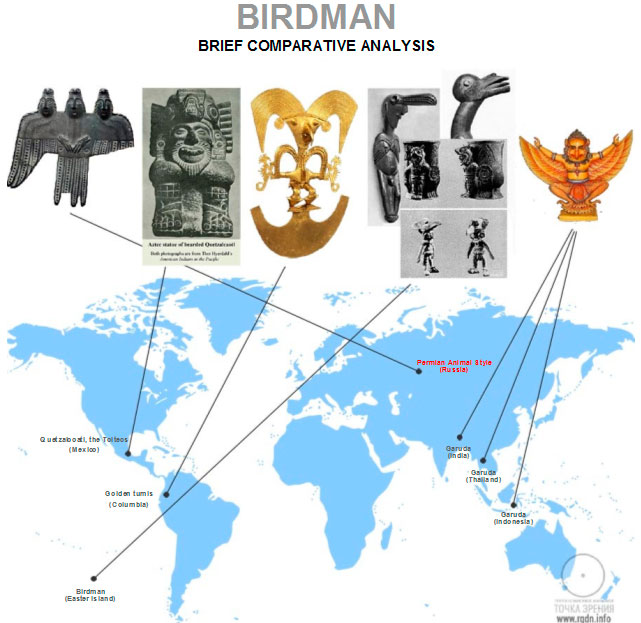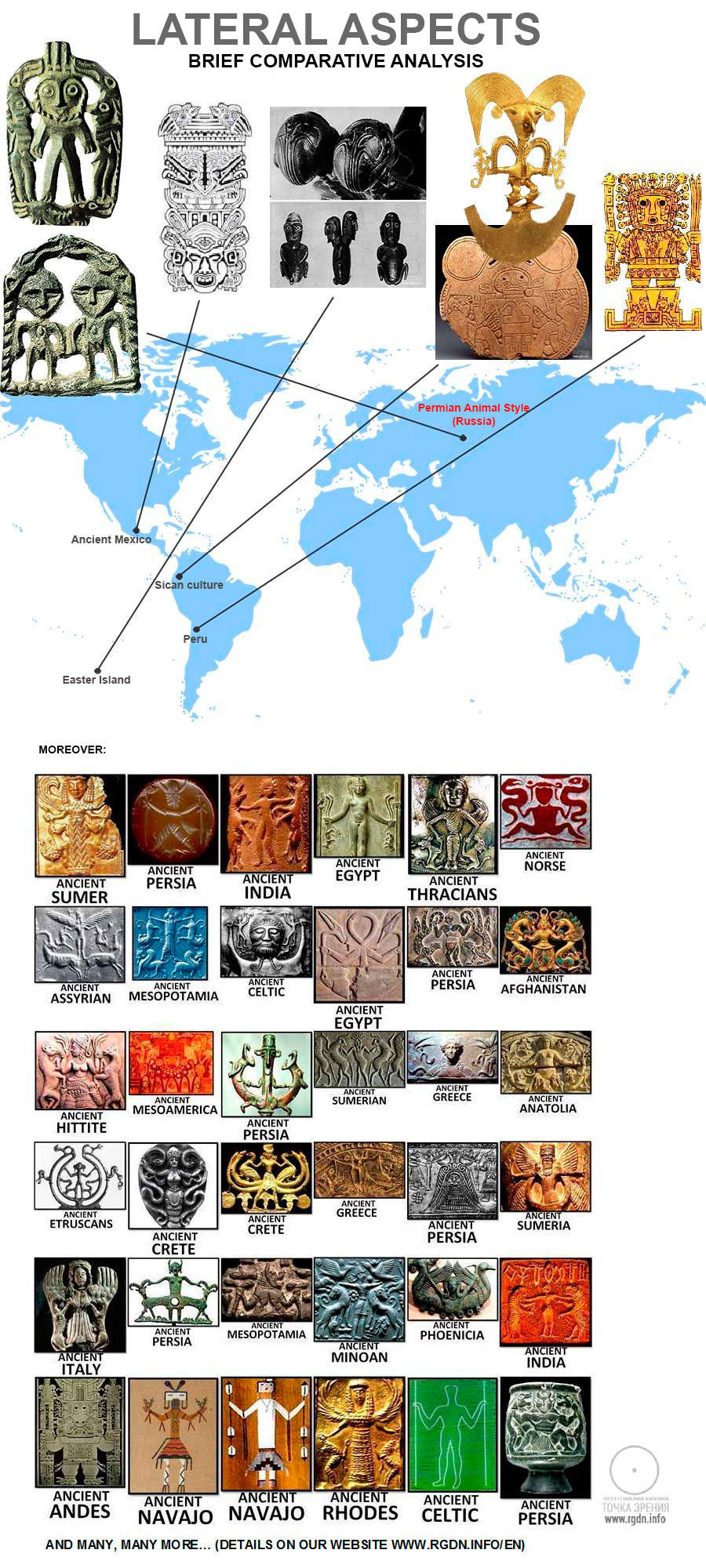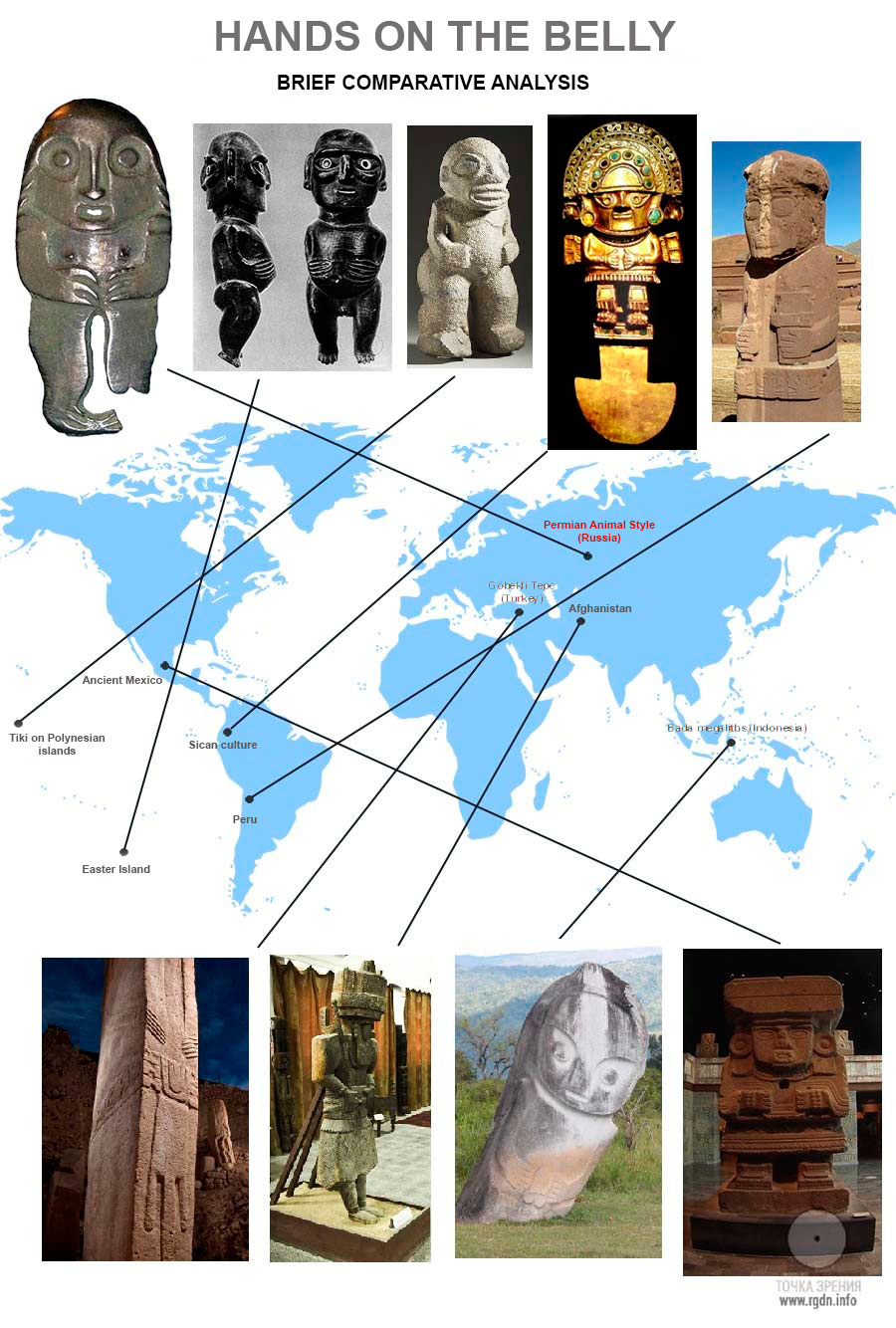We are going on with publication of the Permian Animal Style artefacts, having sorted them by categories we are interested in and having added corresponding explanations to shed light upon the mystery of strange motifs in shaman images, Chud amulets and bronze cult casts. Let me remind of the links to the previous articles of the series:
In the final material dedicated to the Permian Animal Style I will first spilt the image collection into three sections: Three-Faced Beings, Birdman, and Hands on the Belly, then I’ll add several images of “sacred bugs”, and in the end there will be a brief comparative analysis based on photos of artefacts from other ancient cultures, published on our website earlier.
Many people enjoy looking at images, so I will try to be laconic in words and provide convincing visual evidence that the Permian Animal Style is far from being a unique phenomenon, and relevant themes are present in nearly all places where spiritual knowledge flourished. Now, let’s look and compare, based on our previous studies, where the Birdman image was found. Namely, let’s refer to the article series In quest of... A journey to the remote 11th century:
Moreover, the Birdman motif may be associated with Garuda (Sanskrit गरुड, meaning “the all-devouring Sun”). In Hinduism, it’s the mount / riding bird (vahana) of god Vishnu, a fighter against snakes (nagas). In Buddhism, Garuda is one of the symbols of the enlightened mind. Such information is given in Wikipedia, and since the “official know-all” source knows nothing about the true spiritual knowledge so far (or maybe, it knows, but conceals such knowledge due to natural reasons), we will forgive it for the absurd notion of the “enlightened mind”, since it is the same as the “enlightened devil”.

Firstly, I would like to refer to the AllatRa book where it is said that the symbol of a bird is associated with the human Front Aspect (the spiritual one). Furthermore, there is a following remark in Sensei of Shambala – Book IV:
... To be more precise, Ba is the term closest to the notion of the soul. For the ancient Egyptians Ba meant one of the five elements forming a human being. Ba was depicted as a bird (falcon) with a human head, which was flying between the two worlds – the earthly world and the beyond. As the soul, Ba was also considered to be an embodiment of the vital force of all people, which continued existing after people’s death.
And here are the lines from Heaven’s Mirror by Graham Hancock:
... They are all birdmen – men with bird’s wings (spiritually free Personalities), sometimes with bird heads and sometimes with the heads of human beings.
An essentially similar icon of human-headed birds was used in ancient Egypt to symbolize an aspect of the soul – specifically the ba, or ‘heart-soul’. The reader will remember that the ba was thought able to survive in the life hereafter as an independent entity and to have the power of unfettered movement in the Duat like the flight of birds. For this reason it was symbolized as a bird...

For the first time the four human Aspects were described by Rigden Djappo in detail as an integral part of the Primordial Knowledge in the AllatRa book (allatra.us), and on our website we also presented relevant analysis. In particular, you can familiarize yourselves with the article Four human Aspects. Why do contemporaries know nothing about those? The Permian Animal Style is a vivid example of representation of the Aspects that are actually parts of the human energy structure (the first image collection is exactly dedicated to the Aspects).
By the way, as for the three-faced beings (see the first of the three image collections presented in the beginning of this article), we have a separate article on the subject: Three-faced and four-faced beings… New evidence of existence of the four Aspects?

The so-called “hands on the belly” motif is so far a blank spot in our study of artefacts, and the AllatRa book says nothing about it. We can address the subject in a separate article and include there a relevant image collection. If you have any ideas, please share in the commentary section.
The mysterious Perm culture certainly had a great spiritual potential, which is evidenced by the artefacts kept in various museums and private collections, as well as by the comparative analysis we have performed above, being quite convincing in my opinion. Once again we encounter a funny situation when official history and archaeology prefer to invent and believe in savage conjectures, while people who don’t have any special education in these fields, yet are familiar with the basic Primordial Knowledge, easily dot the i's and cross the t's. Owing to the Primordial Knowledge, many secrets get uncovered, ancient texts and scriptures get deciphered, and academic science finds itself in an awkward position.
Well, our comparative analysis shows that representatives of the ancient culture, which existed in the territory of modern Perm Krai in Russia, is abundantly present in the bronze casts and other ancient items unexplained by archaeologists and historians, and known to the world as the Permian Animal Style, possessed the knowledge of personal spiritual liberation, and therefore of God, and regarded spiritual self-development as a priority in their evolution (as distinct from us, the civilization living in the beginning of the 21st century, technocratic yet totally lacking understanding of the sense and meaning of our sojourn on planet Earth). Evaluating the level of sameness of Perm artefacts and items of other spiritually advanced ancient cultures, we may conclude that in the said territory there used to reside bearers of the Primordial Knowledge which was given to people since the dawn of human civilizations and was renewed from time to time when lost. Almost no information is currently available on the Perm culture, and it is no wonder. At that, we have got added evidence that the true Knowledge is single, and now we can only state the following fact: the secret of the Permian Animal Style has been uncovered. Details may be found in the AllatRa book.
Prepared by Dato Gomarteli (Ukraine-Georgia)
 The secret of the Permian Animal Style has been uncovered. Part III: Comparative analysis and conclusions
votes:
90
The secret of the Permian Animal Style has been uncovered. Part III: Comparative analysis and conclusions
votes:
90
|

Project Aim










Leave comment